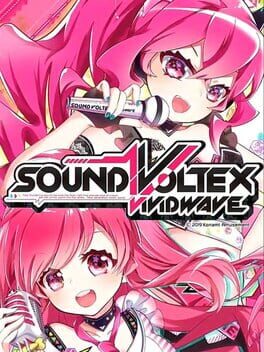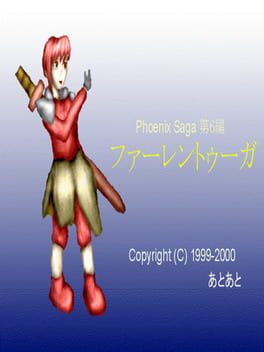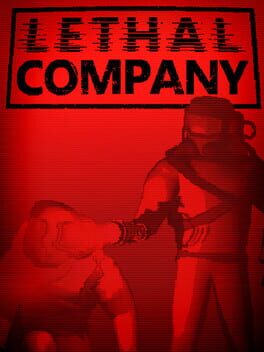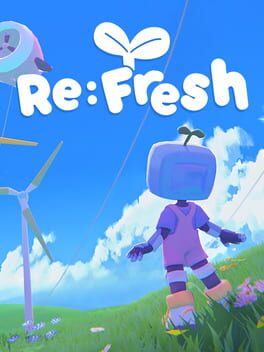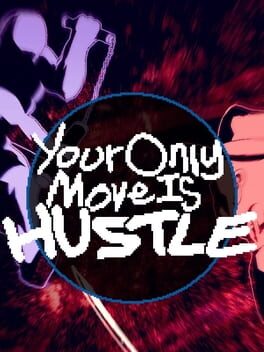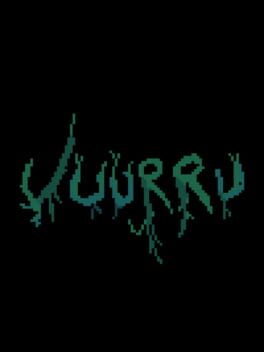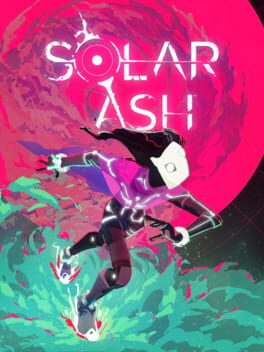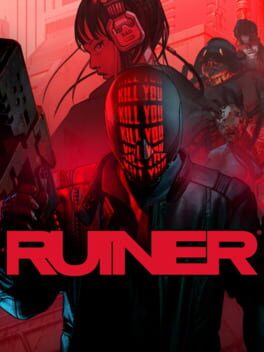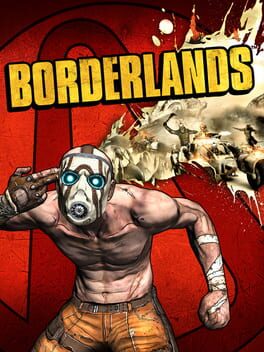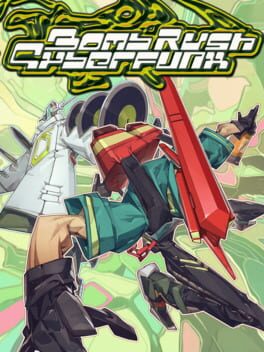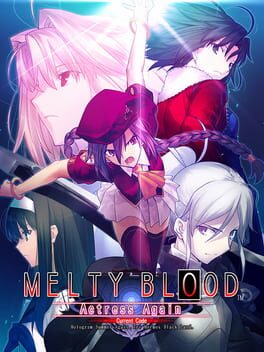186 Reviews liked by bugtechno
Good: It's the [ T O T A L P A C K A G E ] with every conceivable feature you'd need without tarnishing an inch of IIDX's core edge. And on top of that, most of the best retro tracks are still here! These fuckers put a camera in the machine so you can record your hands as you play.
The bad: I don't know what the fuck these mobile game popups and alerts are, why did it force me into this course mode thing but then drop me back into regular song selection, what the goddamn hell is going on here
The bad: I don't know what the fuck these mobile game popups and alerts are, why did it force me into this course mode thing but then drop me back into regular song selection, what the goddamn hell is going on here
when i play this game my hands become high precision weapons of destruction so one time at the arcade my friend put his hand on one of the face buttons just as i was about to press it and my finger poked clean through his palm so now all my friends call him "hole hand" honestly its not that bad because now he can carry a roll of quarters in there so whenever we need to do laundry we just call up ol' hole hand and he spots us also they added hare hare yukai to this one so its good
Faren Touga
1999
Faren Touga is a map-based strategy/simulation game with TRPG combat for each node. This game is genuinely amazing, its janky mechanics, menuing, art, music, and all. You play from one of multiple scenarios, and within each scenario the faction you choose changes where on the map you start, what characters and generic units you have access to, and what story events you can trigger. All of this results in a relative difficulty for the scenario that the game marks for you with a star rating out of 5, with 5 being hardest.
Ok but what's the actual gameplay?
Each node on the world map has a unique tile-based TRPG map, and each map provides some kind of unique layout or challenge. Maybe it's an open field with trees on each side providing cover for attackers, or maybe it's a desert with a slice of a snowy field in a corner. The game is actually mostly built for you to try to use autobattle as much as possible, as they're combat is generally guaranteed from the outset if your units are stronger and not as a strict disadvantage, though manual control allows you to perform more in-depth tactics like spreading your units to avoid aoe magic and protect your backline, or using a high move high attack unit to assassinate the enemy leader. Utilizing the terrain and your units strengths to your own advantage is crucial in your pursuit of world domination. But it's not nearly as important as fostering your economical growth.
Each node/"area" is a city under your rule. You station your troops there and they can do one a few actions, or do nothing and passively contribute to the city's stated development goal. Those goals being developing the city (i.e. building houses), repairing the walls, building roads, training, or searching for allies. Developing the city increases the amount of money (aka "ley") that city provides each turn, training gives all stationed units a bit of exp, and searching for allies has a chance to let you hire a new named character for a certain price + upkeep cost, though they can refuse to serve. I skipped the walls and roads though right? So those actually directly affect the TRPG map the node represents. Each point of wall strength corresponds to 1 wall tile on the map, with those wall tiles stopping enemy units from crossing while providing your units with a ton of avoid for standing on them. The roads work the same way, but standing on road tiles lowers your avoid. Having all the roads built also doubles the income you receive from that city, which is a nice bonus if you don't have anything else to do in that city. Also of note is that developing the city adds house tiles to the map, which sometimes give avoid bonuses as well.
Those active actions your troops have are to hire new troops or monsters, move to another area, or attack a neighboring area. Each city can house 20 units and you can only move one unit one node at a time, which can be a little annoying toward the end where you need to fight along multiple fronts.
The gameplay loop is addicting. Like most strategy games of its kind, you need to stay on your toes and predict enemy movements and guess where and when they will strike, having your own forces nearby and ready to prevent their attack. And because of how city development works, you also have "armies" of weak units that you mainly use to bolster your economy as fast as possible. Having two aspects of strategy you're focusing on at once with both of them using the same clunky menuing and garrisons is surprisingly fun, especially when you find nodes that let you hire particularly strong monsters like dragons and have to ferry all of them through your empire over to the battlefield.
For its time this game is incredibly innovative. More than that though, it has this unmistakable charm like nothing else. It came at the wrong time to really make a splash, but it's still inspired multiple fan versions of it, Varen Touga the most notable. Its spiritual successor Lost Technology is also on Steam in English for $5 if you'd prefer a much more modernized version that doesn't have the territory development focus.
I wrote this review as a half-guide to how the game works because there are no resources for this game in English and I genuinely loved playing this game. It's an incredibly soulful and charming experience that I wish more people knew about. Oh, and did I mention it runs perfectly on Windows 10 and 11?
Check out this dragon deathball I used to kill the lizardmen faction leader this one time: https://i.imgur.com/uN0z19z.png
Ok but what's the actual gameplay?
Each node on the world map has a unique tile-based TRPG map, and each map provides some kind of unique layout or challenge. Maybe it's an open field with trees on each side providing cover for attackers, or maybe it's a desert with a slice of a snowy field in a corner. The game is actually mostly built for you to try to use autobattle as much as possible, as they're combat is generally guaranteed from the outset if your units are stronger and not as a strict disadvantage, though manual control allows you to perform more in-depth tactics like spreading your units to avoid aoe magic and protect your backline, or using a high move high attack unit to assassinate the enemy leader. Utilizing the terrain and your units strengths to your own advantage is crucial in your pursuit of world domination. But it's not nearly as important as fostering your economical growth.
Each node/"area" is a city under your rule. You station your troops there and they can do one a few actions, or do nothing and passively contribute to the city's stated development goal. Those goals being developing the city (i.e. building houses), repairing the walls, building roads, training, or searching for allies. Developing the city increases the amount of money (aka "ley") that city provides each turn, training gives all stationed units a bit of exp, and searching for allies has a chance to let you hire a new named character for a certain price + upkeep cost, though they can refuse to serve. I skipped the walls and roads though right? So those actually directly affect the TRPG map the node represents. Each point of wall strength corresponds to 1 wall tile on the map, with those wall tiles stopping enemy units from crossing while providing your units with a ton of avoid for standing on them. The roads work the same way, but standing on road tiles lowers your avoid. Having all the roads built also doubles the income you receive from that city, which is a nice bonus if you don't have anything else to do in that city. Also of note is that developing the city adds house tiles to the map, which sometimes give avoid bonuses as well.
Those active actions your troops have are to hire new troops or monsters, move to another area, or attack a neighboring area. Each city can house 20 units and you can only move one unit one node at a time, which can be a little annoying toward the end where you need to fight along multiple fronts.
The gameplay loop is addicting. Like most strategy games of its kind, you need to stay on your toes and predict enemy movements and guess where and when they will strike, having your own forces nearby and ready to prevent their attack. And because of how city development works, you also have "armies" of weak units that you mainly use to bolster your economy as fast as possible. Having two aspects of strategy you're focusing on at once with both of them using the same clunky menuing and garrisons is surprisingly fun, especially when you find nodes that let you hire particularly strong monsters like dragons and have to ferry all of them through your empire over to the battlefield.
For its time this game is incredibly innovative. More than that though, it has this unmistakable charm like nothing else. It came at the wrong time to really make a splash, but it's still inspired multiple fan versions of it, Varen Touga the most notable. Its spiritual successor Lost Technology is also on Steam in English for $5 if you'd prefer a much more modernized version that doesn't have the territory development focus.
I wrote this review as a half-guide to how the game works because there are no resources for this game in English and I genuinely loved playing this game. It's an incredibly soulful and charming experience that I wish more people knew about. Oh, and did I mention it runs perfectly on Windows 10 and 11?
Check out this dragon deathball I used to kill the lizardmen faction leader this one time: https://i.imgur.com/uN0z19z.png
Lethal Company
2023
Re:Fresh
2023
got exactly what i wanted, which was a tiny world that i could cozy into and master in less then two hours. appreciate that there is Some effort to stretch the mechanics in different directions even across the very short running time. kinda janky and weirdly poorly optimized if u care ab that stuff (i dont). i have mixed feelings on both "wholesome" games and solarpunk, but this is a pretty good case for the communal, inviting, aspirational best of both. not the most powerful thing, but i do long for the world that will happen when we finally decide to take care of eachother.
Is it weird that I mostly want to talk about Hopping Girl Kohane EX's progression system? For what is a pretty unusual and weird semi-physics based precision action/puzzle platformer with plenty of questionable design decisions, the boring GDC talk topic is its truly compelling bit.
Said progression, of course, is cute clothes. For a game with a rock-bottom budget otherwise, D-O enterprise have put in a stupid amount of outfits. Legitimately as many outfits as there are stages in the entire game, most with unique models, different hairstyles and stuff for our bubbly protagonist Kohane as she basically plays pogo stick monkey ball. They do also come with stat boosts, which is questionable but they're never over the top and never required to get the S ranks or all the coins on a stage.
And that's the real hook of the progression. Those cute outfits can all be bought from a shop for grinded out currency... or you can get an S rank in the stage they're attached to. And as the balance of grind for cash is obnoxious enough, but you really want to see Kohane in the virgin killer sweater (yes, really, how is this game rated 7+ PEGI), the game pushes you to go for those S ranks, to get all the frog coins.
Which is good, because it's in the score attacks where the gameplay itself shines. Played as just a start to finish game like monkey ball Kohane is a pretty mid game, and it's level design is kinda weak. This is something the original kohane suffers heavily from - sprawling, huge levels that miss the point because the path of least resistance and most clothes is beelining it to the finish. When really, the way of playing the game that is by far the most fun is to route out the maps, go for full combos by constantly be jumping on special blocks, do it fast, get all the bonus coins and dont get hit. And then you get rewarded with a cute bolero dress which Kohane looks so happy in...
EX also generally improves on a lot of the general problems of the original, despite largely being comprised of the same assets and structure. The levels are still wide, but nowhere near as labyrinthe, long and massive as lategame OG. General pacing and game speed is higher, and there are a lot more sections of actual perilous precision platforming that will kill you rather than just hurt your rank upon failure. Moving platforms are predictably pure hell to deal with on a pogo stick, and learning how to deal with their timings and how to carry momentum onto them is particularly rewarding.
Kohane EX is a really telling exercise. The original I found, frankly, extremely mid and this sequel is in so many ways as similar to it as Fifa 23 is to Fifa 22 - hell, it removes content such as the championship mode and multiplayer, which is a bit of a shame even if they kinda sucked, and production values for the story is way lower. And yet, through careful repackaging and tweaking of it's formulas and how it's presented, it becomes something pretty great.
Seriously though, how is this game rated 7+ it's like Dead or Alive Extreme level horny at times.
Said progression, of course, is cute clothes. For a game with a rock-bottom budget otherwise, D-O enterprise have put in a stupid amount of outfits. Legitimately as many outfits as there are stages in the entire game, most with unique models, different hairstyles and stuff for our bubbly protagonist Kohane as she basically plays pogo stick monkey ball. They do also come with stat boosts, which is questionable but they're never over the top and never required to get the S ranks or all the coins on a stage.
And that's the real hook of the progression. Those cute outfits can all be bought from a shop for grinded out currency... or you can get an S rank in the stage they're attached to. And as the balance of grind for cash is obnoxious enough, but you really want to see Kohane in the virgin killer sweater (yes, really, how is this game rated 7+ PEGI), the game pushes you to go for those S ranks, to get all the frog coins.
Which is good, because it's in the score attacks where the gameplay itself shines. Played as just a start to finish game like monkey ball Kohane is a pretty mid game, and it's level design is kinda weak. This is something the original kohane suffers heavily from - sprawling, huge levels that miss the point because the path of least resistance and most clothes is beelining it to the finish. When really, the way of playing the game that is by far the most fun is to route out the maps, go for full combos by constantly be jumping on special blocks, do it fast, get all the bonus coins and dont get hit. And then you get rewarded with a cute bolero dress which Kohane looks so happy in...
EX also generally improves on a lot of the general problems of the original, despite largely being comprised of the same assets and structure. The levels are still wide, but nowhere near as labyrinthe, long and massive as lategame OG. General pacing and game speed is higher, and there are a lot more sections of actual perilous precision platforming that will kill you rather than just hurt your rank upon failure. Moving platforms are predictably pure hell to deal with on a pogo stick, and learning how to deal with their timings and how to carry momentum onto them is particularly rewarding.
Kohane EX is a really telling exercise. The original I found, frankly, extremely mid and this sequel is in so many ways as similar to it as Fifa 23 is to Fifa 22 - hell, it removes content such as the championship mode and multiplayer, which is a bit of a shame even if they kinda sucked, and production values for the story is way lower. And yet, through careful repackaging and tweaking of it's formulas and how it's presented, it becomes something pretty great.
Seriously though, how is this game rated 7+ it's like Dead or Alive Extreme level horny at times.
Ikaruga
2001
Its sometime in the year 2000, and Treasure are finishign up production of the best games of all time, Sin and Punishment, and for some fucking reason, in their after work hours, Programmer Atsutomo Nakagawa and artist/director Hiroshi iuchi have put together a prototype for a new game. Masato Maegawa, founder of treasure and by the sounds of it, the best boss of all time, plays it and basically puts his own money on the line, hiring three guys from G.Rev, themselves scrounging enough pennies to make their metal black fangame to assist, and putting the game into full production.
It is one of those realities that is very easy to forget about Ikaruga, now 22 years into it's stint of being "the shmup", and with that has come some sort of monolithic presence. And certainly with it's truly bonkers level of polish, it is hard to imagine it's origin - an absolute flash in the pan, a game that some top level developers really wanted to make, and circumstance and a little risk taking gave them a shot at it.
And you can't say they didn't take it.
Perhaps it is a byproduct of the "one chance to do what you want" reality of Ikaruga that the game is downright pathological in it's approach. And that approach is really the kicker, and usually the thing that draws contention.
Because Ikaruga is rigid as they come. You really have to cast your mind back to the likes of very early toaplan titles like Tiger Heli and Slap fight to find a game where spawns, bullet patterns and stage layouts are essentially locked in, and the game is almost entirely built around really knowing the stages before you go into them, figuring out the best paths through them and executing it perfectly. There's really more resemblance to some fucked up kind of racing game than a wild game like say, Recca. And yes, a lot of shooting games have a strong emphasis on stage knowledge, but Ikaruga is a game that basically shows you the door unless you're prepared to meet it on it's terms. It is a game that can feel comically impossible on a first approach, with stages 3 and 4 in particular being filled with layouts of enemies and bullet hazards that are fast, complex, and will just kill you before you have a chance to properly assess the situation. It can feel outright unfair, and it's probably worth pointing out the Original arcade version came with something ive never seen in any other arcade game - a trial mode which let you play the first two stages with infinite lives on one credit, serving as an introduction for the player to apperciate the mechanics.
And yeah, Ikaruga is a bit gimmicky. I will admit readly it's a game that really took me a while to actually grasp - it's exceptionally easy to appreciate the things about Ikaruga that are obviously exceptional, but especially coming at it as if it's a standard STG, harder to have actual fun with it.
For me, what unlocked that fun was the scoring. Ikaruga is exceptionally tightly tuned, but the scoring is just wonderful - and for me the secret element that tends to go unmentioned is large parts of it are very in line with games like dangan feveron and thunder dragon 2 where enemy spawns are tied to kills, which makes optimising it's chains of 3 enemies and doing it as fast as possible, spawning more in for more points and then you can get more extends and then maybe, just maybe you can beat this thing, right?
And at least for me, when i unlocked that key, when i got my first good run of stage 1, I got it. And from there the beauty of Ikaruga really shows itself. Because yes, doing a cool run of stage 1 is good gameplay - but Ikaruga then pushes this gameplay as far as it will go, with the claustrophobic and more puzzle-y stage 2 and first half of stage 3, to the notorious, exceptional battleship raid of stage 4 with an almost rhythmical quality to it, to the peak caravan-scoring festival of stage 5, each stage with a completley unique and weird boss that puts different elements of the game's mechanics to the test, and really only the first one resembles a traditional STG boss at all. Oh, and you want to quick kill them all.
Learning all these stages, these bosses, understanding their quirks, and understanding the quirks of Ikaruga's own systems, is just about the most satisfying thing i've done in any videogame. And buried deep in there, amongst the routing and execution, the sponteneity and chaos you were sure that Iuchi and Nakagawa hammered out of the game rears it's head again - sometimes in elements of the game itself, like the completely bonkers bonus chain enemies at the end of stage 3 that Superplayers still havent optimised, and the snakes in the final boss' second phase - but more often in yourself. Ikaruga is a game challenging and demanding to the point that even the very best players cannot execute the perfect route every time, and it is in catching the small errors, the deaths, the chain breaks - like a snap of oversteer going down the back end of the nordschleife, they may be mistakes but catching them is part of the thrill.
I would be remiss not to mention Ikaruga's just unbelievable presentation. The key staff member of Ikaruga I havent mentioned yet is Yasushi Suzuki, who's art direction and particularly his mechanical design is absolutely impeccable. The ikaruga ship is as unique and offbeat as the game itself, the designs of enemies and their sihoulettes is perfectly balanced between flavour and function, and on a simple level, the game is just pretty much the best looking 3D STG out there. And I know it really doesn''t matter but goddamn is his Key art, featured in the steam version as backgrounds, just the best.
And yeah i've got to mention the music. Director of Ikaruga Hiroshi Iuchi is not a composer. His main thing was making backgrounds and his jaunt in directing Radiant Silvergun and Ikaruga already seemed like a stretch but just popping out one of the best game soundtracks ever as you do so and then not releasing another piece of music for 22 years is something else. And yes, a lot of it is based around that one motif from "Ideal" but that is fine when your game is 20 minutes long and ideal might be the very best in the long tradition of exceptional STG stage 1 tracks. I simply do not understand how you just do that.
The real cherry on top of Ikaruga is how it works thematically. It's clearly a sequel to the very dour radiant silvergun, a game about breaking the eternal cycle of torment humanity inflicted itself with some buddhist themes, which is hype as shit and awesome in it's own right, but there's also Radiant Silvergun's subtext - that of game development stagnating, devs repeating the same things and refusing to risk - that is really wha the stone-like represents, and Ikaruga takes glee in blowing it up, but it's the game's entire existence and style that refutes it best - and its worth noting in the years between the two, it wasn't alone. In the years between RSG and Ikaruga, in the STG space alone you had the wild Dimahoo, Guwange, Progear, Raycrisis, Mars Matrix to name a few. They, and Ikaruga, are proof that whilst the wheel of samsara might bind us, the capability to change it is there.
The end result of all this is just so special. A lot of STG development history has strokes of lightning in a bottle, but Ikaruga takes the cake. A small bunch of ridiculously talented creatives on the same page (nb. Iuchi has called Nakagawa his "wife" in relation to work on this game) given the chance to make the thing they really wanted to do and threw everything at it. In like a year dev time. I swear, the more you look into Ikaruga the more it feels like an impossible result. And yet it is here, and it is special.
It is one of those realities that is very easy to forget about Ikaruga, now 22 years into it's stint of being "the shmup", and with that has come some sort of monolithic presence. And certainly with it's truly bonkers level of polish, it is hard to imagine it's origin - an absolute flash in the pan, a game that some top level developers really wanted to make, and circumstance and a little risk taking gave them a shot at it.
And you can't say they didn't take it.
Perhaps it is a byproduct of the "one chance to do what you want" reality of Ikaruga that the game is downright pathological in it's approach. And that approach is really the kicker, and usually the thing that draws contention.
Because Ikaruga is rigid as they come. You really have to cast your mind back to the likes of very early toaplan titles like Tiger Heli and Slap fight to find a game where spawns, bullet patterns and stage layouts are essentially locked in, and the game is almost entirely built around really knowing the stages before you go into them, figuring out the best paths through them and executing it perfectly. There's really more resemblance to some fucked up kind of racing game than a wild game like say, Recca. And yes, a lot of shooting games have a strong emphasis on stage knowledge, but Ikaruga is a game that basically shows you the door unless you're prepared to meet it on it's terms. It is a game that can feel comically impossible on a first approach, with stages 3 and 4 in particular being filled with layouts of enemies and bullet hazards that are fast, complex, and will just kill you before you have a chance to properly assess the situation. It can feel outright unfair, and it's probably worth pointing out the Original arcade version came with something ive never seen in any other arcade game - a trial mode which let you play the first two stages with infinite lives on one credit, serving as an introduction for the player to apperciate the mechanics.
And yeah, Ikaruga is a bit gimmicky. I will admit readly it's a game that really took me a while to actually grasp - it's exceptionally easy to appreciate the things about Ikaruga that are obviously exceptional, but especially coming at it as if it's a standard STG, harder to have actual fun with it.
For me, what unlocked that fun was the scoring. Ikaruga is exceptionally tightly tuned, but the scoring is just wonderful - and for me the secret element that tends to go unmentioned is large parts of it are very in line with games like dangan feveron and thunder dragon 2 where enemy spawns are tied to kills, which makes optimising it's chains of 3 enemies and doing it as fast as possible, spawning more in for more points and then you can get more extends and then maybe, just maybe you can beat this thing, right?
And at least for me, when i unlocked that key, when i got my first good run of stage 1, I got it. And from there the beauty of Ikaruga really shows itself. Because yes, doing a cool run of stage 1 is good gameplay - but Ikaruga then pushes this gameplay as far as it will go, with the claustrophobic and more puzzle-y stage 2 and first half of stage 3, to the notorious, exceptional battleship raid of stage 4 with an almost rhythmical quality to it, to the peak caravan-scoring festival of stage 5, each stage with a completley unique and weird boss that puts different elements of the game's mechanics to the test, and really only the first one resembles a traditional STG boss at all. Oh, and you want to quick kill them all.
Learning all these stages, these bosses, understanding their quirks, and understanding the quirks of Ikaruga's own systems, is just about the most satisfying thing i've done in any videogame. And buried deep in there, amongst the routing and execution, the sponteneity and chaos you were sure that Iuchi and Nakagawa hammered out of the game rears it's head again - sometimes in elements of the game itself, like the completely bonkers bonus chain enemies at the end of stage 3 that Superplayers still havent optimised, and the snakes in the final boss' second phase - but more often in yourself. Ikaruga is a game challenging and demanding to the point that even the very best players cannot execute the perfect route every time, and it is in catching the small errors, the deaths, the chain breaks - like a snap of oversteer going down the back end of the nordschleife, they may be mistakes but catching them is part of the thrill.
I would be remiss not to mention Ikaruga's just unbelievable presentation. The key staff member of Ikaruga I havent mentioned yet is Yasushi Suzuki, who's art direction and particularly his mechanical design is absolutely impeccable. The ikaruga ship is as unique and offbeat as the game itself, the designs of enemies and their sihoulettes is perfectly balanced between flavour and function, and on a simple level, the game is just pretty much the best looking 3D STG out there. And I know it really doesn''t matter but goddamn is his Key art, featured in the steam version as backgrounds, just the best.
And yeah i've got to mention the music. Director of Ikaruga Hiroshi Iuchi is not a composer. His main thing was making backgrounds and his jaunt in directing Radiant Silvergun and Ikaruga already seemed like a stretch but just popping out one of the best game soundtracks ever as you do so and then not releasing another piece of music for 22 years is something else. And yes, a lot of it is based around that one motif from "Ideal" but that is fine when your game is 20 minutes long and ideal might be the very best in the long tradition of exceptional STG stage 1 tracks. I simply do not understand how you just do that.
The real cherry on top of Ikaruga is how it works thematically. It's clearly a sequel to the very dour radiant silvergun, a game about breaking the eternal cycle of torment humanity inflicted itself with some buddhist themes, which is hype as shit and awesome in it's own right, but there's also Radiant Silvergun's subtext - that of game development stagnating, devs repeating the same things and refusing to risk - that is really wha the stone-like represents, and Ikaruga takes glee in blowing it up, but it's the game's entire existence and style that refutes it best - and its worth noting in the years between the two, it wasn't alone. In the years between RSG and Ikaruga, in the STG space alone you had the wild Dimahoo, Guwange, Progear, Raycrisis, Mars Matrix to name a few. They, and Ikaruga, are proof that whilst the wheel of samsara might bind us, the capability to change it is there.
The end result of all this is just so special. A lot of STG development history has strokes of lightning in a bottle, but Ikaruga takes the cake. A small bunch of ridiculously talented creatives on the same page (nb. Iuchi has called Nakagawa his "wife" in relation to work on this game) given the chance to make the thing they really wanted to do and threw everything at it. In like a year dev time. I swear, the more you look into Ikaruga the more it feels like an impossible result. And yet it is here, and it is special.
an extremely good attempt - much better than you'd expect at a glance - at recreating the mind games of fighting games without requiring that you grind your bones into dust against the controller to practice combos. it's a little opaque (would be nice if the game told me how to identify when the next turn happens instead of a steam guide) but is extremely rewarding nonetheless.
i understand why people keep throwing around the word "chess" when discussing this but i think for non-players this makes it sound like a game that lacks immediacy. you might spend a full 30 seconds planning for a "turn" that lasts 4 frames but those 4 frames can still be more rewarding than any single turn in normal chess would ever be, thanks to some chunky, bitcrushed sound effects. this kinda arrangement extends the satisfaction of a well-executed combo as long as possible and it rocks. game's funny too. nothing better than ending a turn, watching some completely innocuous shit happen for a whopping 6 frames, and then getting a message that just says "shit".
uh, play it with friends though, the playerbase is small enough that people don't always respect the "beginners only" lobby
i understand why people keep throwing around the word "chess" when discussing this but i think for non-players this makes it sound like a game that lacks immediacy. you might spend a full 30 seconds planning for a "turn" that lasts 4 frames but those 4 frames can still be more rewarding than any single turn in normal chess would ever be, thanks to some chunky, bitcrushed sound effects. this kinda arrangement extends the satisfaction of a well-executed combo as long as possible and it rocks. game's funny too. nothing better than ending a turn, watching some completely innocuous shit happen for a whopping 6 frames, and then getting a message that just says "shit".
uh, play it with friends though, the playerbase is small enough that people don't always respect the "beginners only" lobby
Juurru
2023
"I had a dream I was under the ground
My friends and family were buried all around
A worm took a bite of me
And then he washed it down with a bite of you, a bite of you
The same worms that eat me will someday eat you too"
Juurruu is a short grid-based puzzler about sprouting roots from ancient fauna, with 24 caves to dig through.
Three chapters, each with a twist on the same radicle, but Juurruu just knows at what length to tie them up, before they get strained.
Sound design polish like Frédéric Chopin. (Sorry, I can never stop myself)
The 1-Bit creature merrily waddles to the chiptune when you guide them through the door you just opened for it.
I got this recommend by @Erato_Heti a month ago, because Rain World is my favourite game of all time and I can kinda see the reason why, not just for the fact that you play a little white rodant who crawls through boxy shapes, but also for it's desire to go at least a bit deeper. Because after reaching it's depth mechanically, kind of confusingly somewhere in the middle of the game, Juurru almost ditches that effort in favour of a more story-approached conclusion, which I honestly appreciate much more than if it squeezed any small drop left out of it self.
It has it's ups and downs after that inside the levels, but for it's short playtime it is definitely more than worth checking out being a completely free experience.
My friends and family were buried all around
A worm took a bite of me
And then he washed it down with a bite of you, a bite of you
The same worms that eat me will someday eat you too"
Juurruu is a short grid-based puzzler about sprouting roots from ancient fauna, with 24 caves to dig through.
Three chapters, each with a twist on the same radicle, but Juurruu just knows at what length to tie them up, before they get strained.
Sound design polish like Frédéric Chopin. (Sorry, I can never stop myself)
The 1-Bit creature merrily waddles to the chiptune when you guide them through the door you just opened for it.
I got this recommend by @Erato_Heti a month ago, because Rain World is my favourite game of all time and I can kinda see the reason why, not just for the fact that you play a little white rodant who crawls through boxy shapes, but also for it's desire to go at least a bit deeper. Because after reaching it's depth mechanically, kind of confusingly somewhere in the middle of the game, Juurru almost ditches that effort in favour of a more story-approached conclusion, which I honestly appreciate much more than if it squeezed any small drop left out of it self.
It has it's ups and downs after that inside the levels, but for it's short playtime it is definitely more than worth checking out being a completely free experience.
Solar Ash
2021
Hyper Light Drifter
2016
+gorgeous architecture, excellent pixel art, distinctive character designs
+once the combat options open up it feels pretty rewarding, especially once you get meatier guns that can server the majority of your damage output
+overall I think the text-less nature of the game suits it, partially because each area follows a pattern in terms of progression so there's never any confusion over what to do
+I actually quite liked the final boss in this game, it's easy to fumble a final boss by trying to make it too wild or insane but this boss felt challenging and momentous without throwing the combat design out the window. the bosses in general succeeded when they took inspiration from bullet hell games to create interesting obstacles for the player, and/or had dynamic patterns as the fight went on; the bosses that did this really struck a chord with me
+other than the west quadrant each other quadrant felt like they had a natural progression when figuring out where to go next and what to do. it's more linear than the zelda games it was based on no question, but it felt comfortable to be always moving forward
+exploration is virtually always rewarded, whether with upgrade currency, extra health packs, or even keys or hidden modules
-the west quadrant... wow what a terrible start to the game for me. the modules in this area were significantly more hidden than in the others, and the backtracking to comb over areas where I had already been was not fun at all
-certain aspects definitely reflect the indie game maker development of this game. what stuck out to me most were objects with incorrect priority that would hover over the drifter when they were supposed to be behind him
-boss design is a little all over the place, some seem very undercooked and trivial to take down
-didn't really care for the enemy and encounter design that much. the enemy patterns didn't feel distinctive in how they were meant to be taken down, and "difficult" encounters just consisted of throwing a bunch of enemies at you at once
-aiming the gun sucks lol. aiming in place is never worth it and even when I would move and shoot in a direction sometimes it felt like the bullets would skew
I really did not like this game initially because of the issues I mentioend with the west quadrant, but for the rest of the game I found it to be quite relaxing because of the ease of progression and pretty locales. afterwards I really felt no push to continue exploring, but for the 7 or 8 hours I spent playing it otherwise I was quite content. it's not a long game and pretty cheap, so I would absolutely recommend as a quick game to go through if you're proficient with 2d combat and looking for a solid entry in that space
+once the combat options open up it feels pretty rewarding, especially once you get meatier guns that can server the majority of your damage output
+overall I think the text-less nature of the game suits it, partially because each area follows a pattern in terms of progression so there's never any confusion over what to do
+I actually quite liked the final boss in this game, it's easy to fumble a final boss by trying to make it too wild or insane but this boss felt challenging and momentous without throwing the combat design out the window. the bosses in general succeeded when they took inspiration from bullet hell games to create interesting obstacles for the player, and/or had dynamic patterns as the fight went on; the bosses that did this really struck a chord with me
+other than the west quadrant each other quadrant felt like they had a natural progression when figuring out where to go next and what to do. it's more linear than the zelda games it was based on no question, but it felt comfortable to be always moving forward
+exploration is virtually always rewarded, whether with upgrade currency, extra health packs, or even keys or hidden modules
-the west quadrant... wow what a terrible start to the game for me. the modules in this area were significantly more hidden than in the others, and the backtracking to comb over areas where I had already been was not fun at all
-certain aspects definitely reflect the indie game maker development of this game. what stuck out to me most were objects with incorrect priority that would hover over the drifter when they were supposed to be behind him
-boss design is a little all over the place, some seem very undercooked and trivial to take down
-didn't really care for the enemy and encounter design that much. the enemy patterns didn't feel distinctive in how they were meant to be taken down, and "difficult" encounters just consisted of throwing a bunch of enemies at you at once
-aiming the gun sucks lol. aiming in place is never worth it and even when I would move and shoot in a direction sometimes it felt like the bullets would skew
I really did not like this game initially because of the issues I mentioend with the west quadrant, but for the rest of the game I found it to be quite relaxing because of the ease of progression and pretty locales. afterwards I really felt no push to continue exploring, but for the 7 or 8 hours I spent playing it otherwise I was quite content. it's not a long game and pretty cheap, so I would absolutely recommend as a quick game to go through if you're proficient with 2d combat and looking for a solid entry in that space
Ruiner
2017
On the foggy streets of Rengkok South, destitute cyborgs loiter around flickering neon lights, spread thin under the towering headquarters of the HEAVEN Corporation. Painted in the rust of body mods and neurotechnology, bodies are thrown into the cybernetic grinder, a new coat of inescapable sickly red floods the alleyways and crosswalks. Bound to black market contracts and transhumanist dehumanization, the denizens of this neo-Purgatory live cheap lives and meet horrid ends.
Cut whole cloth from the script of a thousand cyberpunk stories, RUINER’s world isn’t a unique one. Biotech gone amuck, Capitalism encroaches on it’s hellish end state, and the only person willing to stand up to the one watching over it all is a faceless, nameless psychopath. A story sold to the tune of “whoa, cool robot”, the game wears its influences on its sleeve. A dash of Akira here, a slice of Ghost in the Shell there, some odd Berserk nods to taste. RUINER isn’t an original story by any stretch, but in all reality, you don’t come to it expecting some groundbreaking plot. You expect hyperviolence; grindhouse extremity backlit by LEDs, a crimson wash from a lead pipe brush, to the head splitting tones of weapons-grade darkwave and witch house.
A surface level comparison to Hotline Miami is obvious, I mean, same publisher, same gorehound vibe, same top-down arcade pastiche, complete with timers and letter grades, and a high dose of difficulty to put it above its contemporaries… RUINER and it’s 80s tinged buddy are close, but where the comparison falls apart is in the feel. Don’t get me wrong, there’s a load of mechanical similarities connecting the two, but whereas the former thrives on the minute-to-minute tension of quick, unrelenting death, where a single mistake will spell a splatterhouse finale for our favorite Drive wannabe, RUINER rips through swaths of nameless corporate goons and extremist mercenaries, flipping through an endless array of weapons, blasting, cleaving, and crushing anyone in his path, packing frag grenades, reality bending energy shields, and flash-steps out of a shonen anime. It’s comparing a sociopathic mad lad with a mask fetish to a literal murdering machine, who… also has a fancy mask. Maybe the comparison isn’t so unheard of.
Gameplay wise, RUINER doesn’t stand out as exemplary, sitting somewhere between mediocre and alright depending on the moment-to-moment twists the game throws at you. The one and only area the game fully strives on is it’s presentation. The moment the feel of the world clicked for me was wandering the streets of Rengkok South, a wall of fog casting a smoky haze. As I walked by Time’s Square-style LED billboards, the mournful wails of Susumu Hirasawa’s Island Door cut through the mist, a second of harmony between the soundscape and the world that Reikon Games built out of an obvious love of the genre. There’s very little I loved about RUINER, but the style of the game deserves mention, especially in regards to the soundtrack.
RUINER is deeply flawed, and I don’t see much reason for anyone to stick through until the end: I mostly did because I found a single character cute, and anyone who knows me will guess who in about zero seconds. But as a replication of a setting that’s been done to death and patched together again, it shows such an obvious love for the inspirations surrounding it. That’s not enough to make an interesting game, but it’s enough to make me think fondly of this weird, messy, flawed shooter.
Cut whole cloth from the script of a thousand cyberpunk stories, RUINER’s world isn’t a unique one. Biotech gone amuck, Capitalism encroaches on it’s hellish end state, and the only person willing to stand up to the one watching over it all is a faceless, nameless psychopath. A story sold to the tune of “whoa, cool robot”, the game wears its influences on its sleeve. A dash of Akira here, a slice of Ghost in the Shell there, some odd Berserk nods to taste. RUINER isn’t an original story by any stretch, but in all reality, you don’t come to it expecting some groundbreaking plot. You expect hyperviolence; grindhouse extremity backlit by LEDs, a crimson wash from a lead pipe brush, to the head splitting tones of weapons-grade darkwave and witch house.
A surface level comparison to Hotline Miami is obvious, I mean, same publisher, same gorehound vibe, same top-down arcade pastiche, complete with timers and letter grades, and a high dose of difficulty to put it above its contemporaries… RUINER and it’s 80s tinged buddy are close, but where the comparison falls apart is in the feel. Don’t get me wrong, there’s a load of mechanical similarities connecting the two, but whereas the former thrives on the minute-to-minute tension of quick, unrelenting death, where a single mistake will spell a splatterhouse finale for our favorite Drive wannabe, RUINER rips through swaths of nameless corporate goons and extremist mercenaries, flipping through an endless array of weapons, blasting, cleaving, and crushing anyone in his path, packing frag grenades, reality bending energy shields, and flash-steps out of a shonen anime. It’s comparing a sociopathic mad lad with a mask fetish to a literal murdering machine, who… also has a fancy mask. Maybe the comparison isn’t so unheard of.
Gameplay wise, RUINER doesn’t stand out as exemplary, sitting somewhere between mediocre and alright depending on the moment-to-moment twists the game throws at you. The one and only area the game fully strives on is it’s presentation. The moment the feel of the world clicked for me was wandering the streets of Rengkok South, a wall of fog casting a smoky haze. As I walked by Time’s Square-style LED billboards, the mournful wails of Susumu Hirasawa’s Island Door cut through the mist, a second of harmony between the soundscape and the world that Reikon Games built out of an obvious love of the genre. There’s very little I loved about RUINER, but the style of the game deserves mention, especially in regards to the soundtrack.
RUINER is deeply flawed, and I don’t see much reason for anyone to stick through until the end: I mostly did because I found a single character cute, and anyone who knows me will guess who in about zero seconds. But as a replication of a setting that’s been done to death and patched together again, it shows such an obvious love for the inspirations surrounding it. That’s not enough to make an interesting game, but it’s enough to make me think fondly of this weird, messy, flawed shooter.
Borderlands
2009
Bomb Rush Cyberfunk
2023
This game is style incarnate, makes you feel cool almost all the time, and the ost is so good. The combat system is terrible, which wouldn't be a problem if you weren't forced to enagage with it, every enemy is a sponge, and attacks have no weight, it never feels satisfying. Made even more baffling when you realise this came from the same group who made Lethal League

